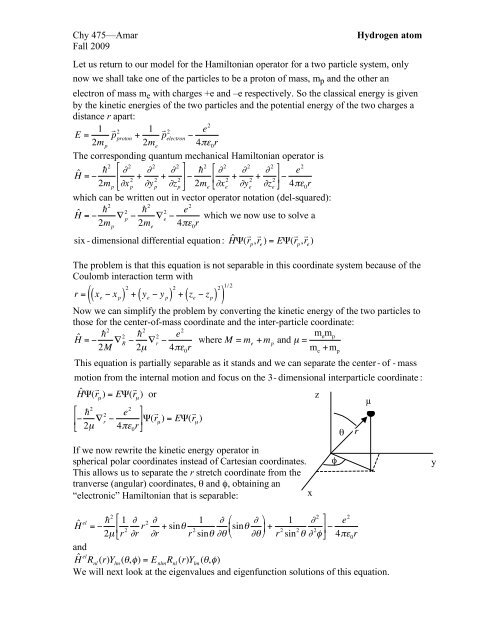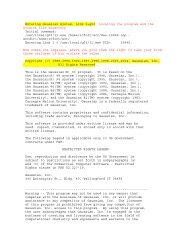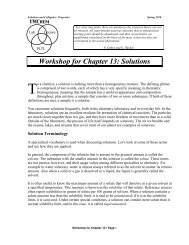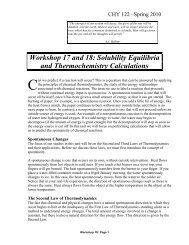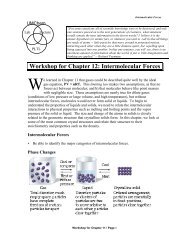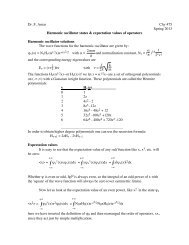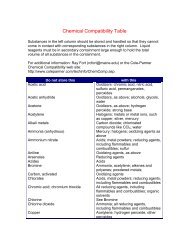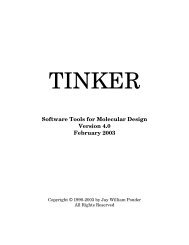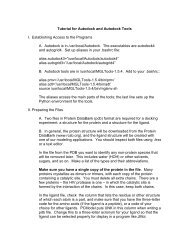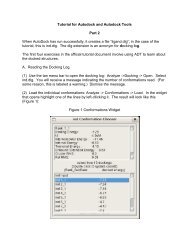Hydrogen atom Hamiltonian (pdf)
Hydrogen atom Hamiltonian (pdf)
Hydrogen atom Hamiltonian (pdf)
You also want an ePaper? Increase the reach of your titles
YUMPU automatically turns print PDFs into web optimized ePapers that Google loves.
Chy 475—Amar<strong>Hydrogen</strong> <strong>atom</strong>!Energy eigenvalues are given by:E nlm= E n= " µe42n 2 h 2 = " 1 n 2 R Hwhich agrees with the Bohr result. Notice that the eigenvalue which could in principledepend on all three quantum numbers n,l , and m depends only on n (in the absence of anexternal field). In this equation,n is called the principal quantum number [n=1,2,3,…]l is called the angular quantum number [l=0,1,…,(n-1)]m is called the magnetic quantum number [m=-l,-l+1,…,-1,0,1,…l-1,+l]If each combination of possible values of the quantum numbers corresponds to a separatestate, we see that energy levels corresponding to n have n 2 degenerate states (withelectron spin, this number becomes 2n 2 ).<strong>Hydrogen</strong> <strong>atom</strong> eigenfunctions are a product of a radial part and an angular part.Together we call this the “spatial” part of the wavefunction (as opposed to the “spin” partwhich we will discuss separately)The angular functions, Y lm (θ,φ), are called the spherical harmonics. The first few aregiven in the first two columns of the following Table. The first few radial functions aregiven in the last two columns of the Table.Y 00Y 11Y 10!Y 1-1!Y 22!Y 21!Y 20! Y 2-1! Y 2-2!!!1R 10( 4" ) 1/ 23( 8" ) 1/ 2 sin#e i$ R 203( 4" ) 1/ 2 cos# R 21( ) 1/ 2 sin#e $i% R 3038"15( 32" ) 1/ 2 sin 2 #e 2i$ R 3115( 8" ) 1/ 2 sin# cos#e i$ R 325( 16" ) 1/ 2 (3cos 2 # $1)15( 8" ) 1/ 2 sin# cos#e $i%( ) 1/ 2 sin 2 #e $2i%1532"!!!!!"2$ 1%3 / 2' e (r / a# a&# 12 "1/ 2 % &3 / 2#( 1" r &"r / 2a% ( e$ a'$ 2a'! # 1(24) "1/ 2 % &5 / 2"r / 2a( re$ a'2 " 1$ %3 / 2"' 1( 2r3 3 # a&3a + %$2r2 ' e# 27a 2&8 " 1$ %3 / 2"r'27 6 # a&a ( %$r2' e# 6a 2&4 " 1$ %81 30 # a&In the above,!7 / 2'r 2 (r / 3ae(r / 3aa = h2 4"# 0µe 2(r / 3a
Chy 475—Amar<strong>Hydrogen</strong> <strong>atom</strong>How should all these formulae be changed if hydrogen <strong>atom</strong> is replaced by a hydrogenic<strong>atom</strong> or ion such as He + ?


